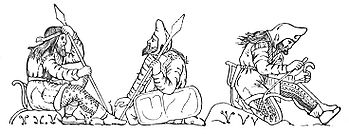
Kul-Oba
Encyclopedia

Kurgan
Kurgan is the Turkic term for a tumulus; mound of earth and stones raised over a grave or graves, originating with its use in Soviet archaeology, now widely used for tumuli in the context of Eastern European and Central Asian archaeology....
), located near Kerch
Kerch
Kerch is a city on the Kerch Peninsula of eastern Crimea, an important industrial, transport and tourist centre of Ukraine. Kerch, founded 2600 years ago, is considered as one of the most ancient cities in Ukraine.-Ancient times:...
in eastern Crimea
Crimea
Crimea , or the Autonomous Republic of Crimea , is a sub-national unit, an autonomous republic, of Ukraine. It is located on the northern coast of the Black Sea, occupying a peninsula of the same name...
, Ukraine
Ukraine
Ukraine is a country in Eastern Europe. It has an area of 603,628 km², making it the second largest contiguous country on the European continent, after Russia...
, on the right side of the M25 road to Feodosiya.
Kul-Oba was the first Scythian royal barrow to be excavated in modern times. Uncovered in 1830, the stone tomb yielded a wealth of precious artefacts which drew considerable public interest to Scythian world. Of particular interest is an intricately granulated earring
Earring
Common locations for piercings, other than the earlobe, include the rook, tragus, and across the helix . The simple term "ear piercing" usually refers to an earlobe piercing, whereas piercings in the upper part of the external ear are often referred to as "cartilage piercings"...
with two Nike
Nike (mythology)
In Greek mythology, Nike was a goddess who personified victory, also known as the Winged Goddess of Victory. The Roman equivalent was Victoria. Depending upon the time of various myths, she was described as the daughter of Pallas and Styx and the sister of Kratos , Bia , and Zelus...
figurines, now in the Hermitage Museum
Hermitage Museum
The State Hermitage is a museum of art and culture in Saint Petersburg, Russia. One of the largest and oldest museums of the world, it was founded in 1764 by Catherine the Great and has been opened to the public since 1852. Its collections, of which only a small part is on permanent display,...
, St. Petersburg.http://www.hermitagemuseum.org/html_En/03/hm3_10-1_01.html
The tomb was built around 400 to 350 BC, likely by a team of Greek masons from Panticapaeum
Panticapaeum
Panticapaeum , present-day Kerch: an important city and port in Taurica , situated on a hill Panticapaeum (Greek: Παντικάπαιον, Pantikápaion), present-day Kerch: an important city and port in Taurica (Tauric Chersonese), situated on a hill Panticapaeum (Greek: Παντικάπαιον, Pantikápaion),...
. Its plan is almost square, measuring 4.6 by 4.2 meters. The stepped vault stands 5.3 meters high. The timber ceiling seems to have been designed to imitate a Scythian wooden tent; it is decorated by a canopy with gold plaques.
The body of the king lay by the east wall on a sumptuous wooden couch. His social position was highlighted by a diadem encircling his head, surmounted by a pointed felt headgear with gold pendants. His neck was decorated by a large gold disk weighing 461 grams. Each wrist was adorned with one to three bracelets. A separate section of the couch contained other grave goods, including a phial, a whip, a knife, and a quiver - all inlaid with gold or precious stones.
To the left of the couch stood a sarcophagus
Sarcophagus
A sarcophagus is a funeral receptacle for a corpse, most commonly carved or cut from stone. The word "sarcophagus" comes from the Greek σαρξ sarx meaning "flesh", and φαγειν phagein meaning "to eat", hence sarkophagus means "flesh-eating"; from the phrase lithos sarkophagos...
made of cypress wood and ivory. A woman, probably the king's wife or concubine, lay there. Apart from the brocaded dress, her body was decorated with an electrum
Electrum
Electrum is a naturally occurring alloy of gold and silver, with trace amounts of copper and other metals. It has also been produced artificially. The ancient Greeks called it 'gold' or 'white gold', as opposed to 'refined gold'. Its color ranges from pale to bright yellow, depending on the...
diadem with large gold pendants, a pair of open-work earrings, a gold disk, a gold necklace, and two gold bracelets. At her side was placed a bronze hand-held mirror with the gilded handle. An electrum cup, placed between her feet, depicts scenes from Scythian mythology (illustrated, to the right).
The remains of a slave (probably a charioteer) were discovered by the south wall. A special niche in the wall contained horse bones, a helmet, a bronze sheath, and two spearheads. Several silver bowls and bronze cauldrons containing lamb bones were placed along the walls of the tomb. Inside the amphora
Amphora
An amphora is a type of vase-shaped, usually ceramic container with two handles and a long neck narrower than the body...
e were residual traces of dried wine. A number of bronze arrow-heads were scattered around the floor.
The archaeologists in charge of the dig did not suspect there was a secret room underneath the tomb. Though it was discovered and plundered by treasure hunters, some of the missing valuables were subsequently retrieved by the Russian government.

